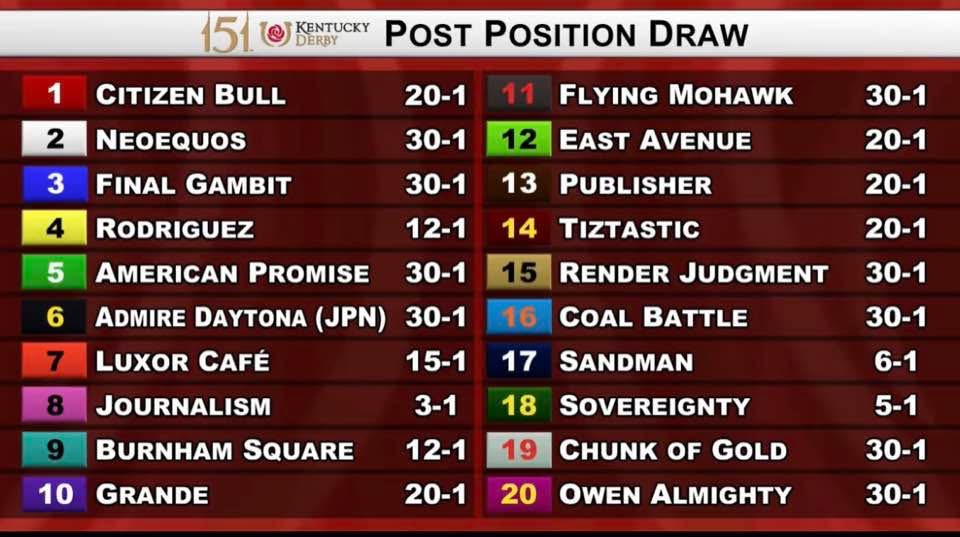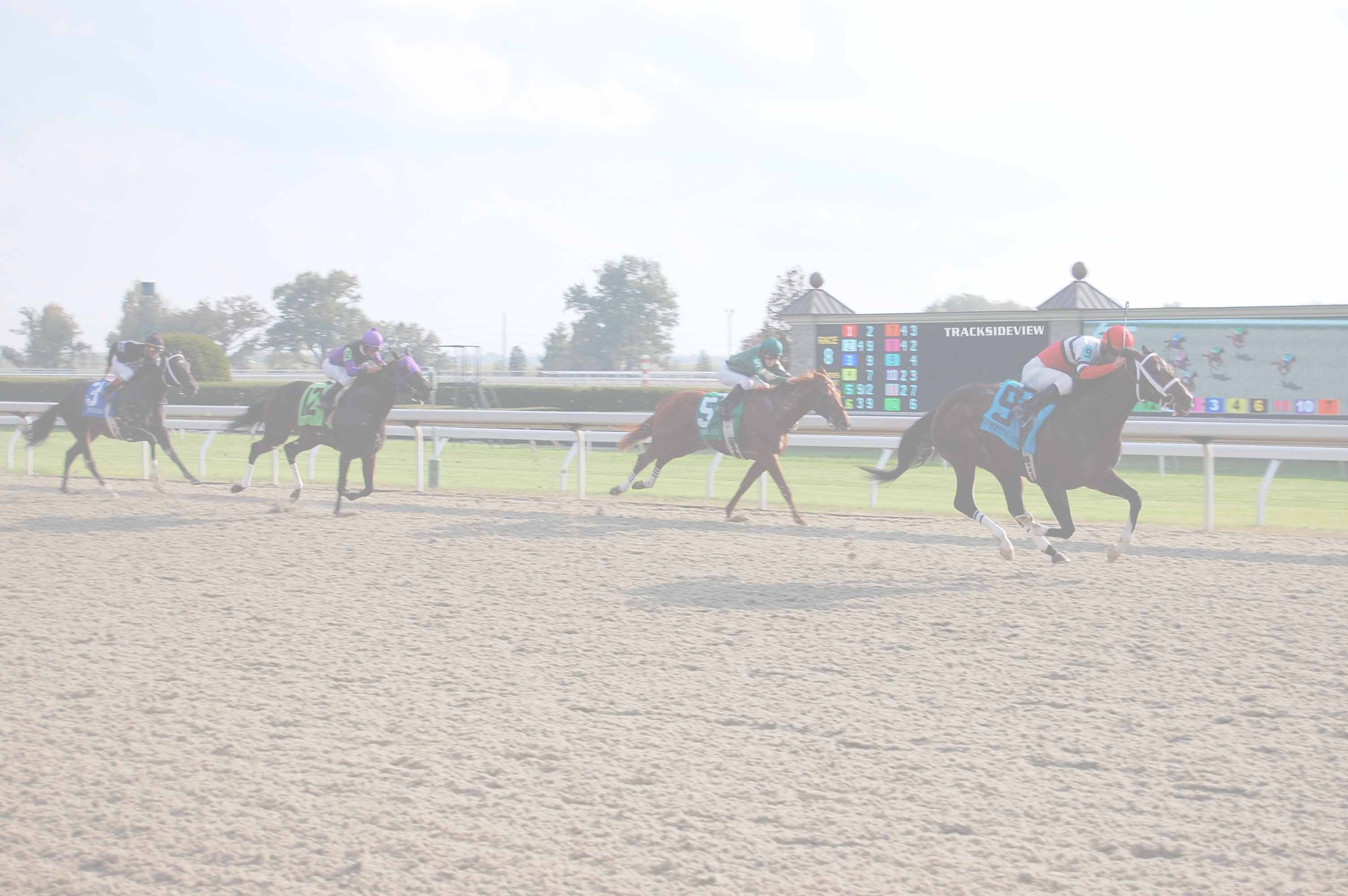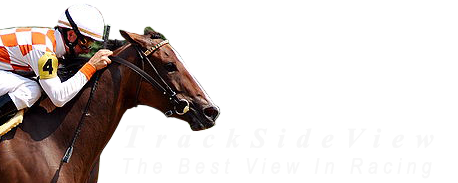View from the Grandstand: Kentucky Derby – Pace and Trip
Bob Hill, TSV staff writer

Among the hard lessons we learn as horse players is that the best
horse does not always win. Sometimes the best horse just has an off
day. More often, however, the best horse may not win due to what
happens in a race – he misses the break, another horse interferes with
his running lane, his jockey makes an error in judgment, and countless
more “bad luck” scenarios. Chaos reigns in horseracing, and one race
that confirms that every year is the Kentucky Derby. Every horse in
the field is trying to run a longer distance than he has ever run
before. The field size of 20 is at least double the size of those in
which he has been competing. The number of “bad luck” scenarios are
multiplied for many of the runners. The crowd noise is a once in a
lifetime experience. I once joined a group interview with Steve
Asmussen, the winningest trainer of all time, who told us that when
the Derby field passes the finish line the first time after the break
that half the field is hopelessly done for already with no chance to
win.
I had the chance during this past week to be in a conversation with a
small group of veteran players and handicappers to talk about Kentucky
Derby 151. We did not try to narrow all the way down to our top
picks, but it would not have been difficult to discern which ones each
of us likes based on the conversation. But what is worth my sharing
with you, the reader, is the absolute consensus that the Kentucky
Derby outcome boils down to which horse gets the trip. Another way of
saying that is which horse or horses navigate the 10 furlongs with the
least amount of the “bad luck” scenarios like those listed above. At
the top of the list impacting the trip for the entire field is the
pace. Then within the pace scenario that unfolds the other factors
come into play.
Without getting overly mathematical, the early pace of a race is
described as slow, average, or fast. What we know is that how fast
the frontrunners cover the opening half-mile (four furlongs) and how
close those following that pace are to those frontrunners will
determine which ones have the stamina to be running fast enough at the
end of the race where the winner will be determined. Put simply, the
axiom that fast early produces slow late for a horse is almost
ironclad true. So is the opposite pace scenario of slow early
produces fast late. Only on the rarest of occasions has a horse run a
race like Secretariat did in the Belmont Stakes where he just plain
outran the competition early, middle, and late.
Fortunately for handicappers, we have access to data that indicate the
preferred running styles of the horses entered in the Kentucky Derby.
Most trainers will develop the style that best fits each particular
horse. Knowing the preferred running styles of the horses helps us
figure out what the “likely” pace scenario will be. Having an idea of
the likely pace scenario helps us then narrow down the list of horses
with a chance to win if that pace scenario unfolds. Three races
longtime fans usually remember are the Kentucky Derbies won by the
longshots Giacamo, Mine That Bird, and Rich Strike. In the races won
by Giacomo and Rich Strike the early pace was torrid (45.38 and 45.36
seconds for the first four furlongs), and every horse near that pace
got cooked as well, setting up the ones coming from the back of the
pack. The early pace was not as fast for Mine That Bird, but his rail
skimming trip going from 18th to first is legendary. On the other
hand, Authentic won the Derby going gate to wire with opening
fractions that were on the fast side of average (46.41 seconds), but
he had the stamina to keep producing solid fractional times for the
remaining mile of the race and no one gave him a serious challenge.
So here is the point: If you are trying to pick a winner based on
more that your favorite name or number, you should start by trying to
figure out if the early pace is going to be fast, average, or slow.
If you get that part right, you can reduce the number of likely
winners from which to choose.
In this year’s Derby the preferred running styles of eight entries are
to run fast early on or near the lead.
That’s 40% of the field, an insanely large number of horses. Logic
will tell us that something will have to give when the race starts
because eight vying for the lead is nearly impossible – certainly
improbable. That means some of those eight will by intent or
circumstance be father back at the start than they normally like to be
(and where they were in races when they won or finished well). If
three or more of this bunch get hooked up going fast early they will
increase the odds for the closers and decrease the chances of any in
the group that is close to their pace. Interestingly, five of the
eight are drawn to inside posts from the rail to the six hole. The
start will be VERY interesting. These eight early speed horses with
their listed post positions and morning line odds are: 1 – Citizen
Bull (20-1); 2 – Neoequos (30-1); 4 – Rodriguez (12-1); 5 —
American Promise (30-1); 6 – Admire Daytona (30-1); 10 – Grande
(20-1); 12 East Avenue (20-1); and 20 – Owen Almighty (20).
Behind that group of eight there is another group of three horses that
possess good early speed but typically try to run in the second group
of horses just a few lengths behind the pacesetters. These horses
usually possess good tactical speed (start and stop) in addition to
flat out being fast. The best ones are referred to as “push button”
horses. Tactical speed helps horses overcome traffic problems and
avoid or overcome “bad luck” issues. This is the profile of many of
the best horses in the history of the sport. These horses love an
average pace, and if the pace is hot they must guard against getting
too close to the leaders early in the race. This year’s favorite, 8
–Journalism (3-1) is in this group along with 7 — Luxor Café
(15-1) and 16 — Coal Battle (30-1). As noted above, it is likely
that at least a couple of the horses listed in the first group will be
relegated to this group due to the presence of eight pacesetting types
in this race.
The third group, typically running mid-pack early in an average race,
are horses that likely will make a sustained run entering the far turn
of a race and try to wear down the tiring horses ahead of them. In
an average race, mid-pack is fifth or sixth place. In the Derby, the
mid-pack runner may have 10 or more horses in front of them to pass.
That means the jockeys on these horses have to navigate traffic and
time their run just right to have a chance to win. This group of
mid-pack pressers includes: 9 — Burnham Square (12-1); 11 — Flying
Mohawk (30-1); 13 – Publisher (20-1;, and 15 — Render Judgment
(30-1).
The final group contains 25% of the field. These are the ones that
make one long sustained run from out of the clouds to pass nearly all
of the field. They all should benefit from a fast early pace if that
occurs. Navigating traffic is critical. Recent Derby winners of this
type also suggest that passing on the inside of the field rather than
the outside is a better approach. However, most are conditioned to
do the opposite of that and make sweeping outside moves. This year’s
group includes: 3 — Flying Gambit (30-1); Sovereignty, 14 –
Tiztastic (20-1); 17 – Sandman (6-1); 18 – Sovereignty (5-1); and 19
— Chunk of Gold (30-1).
So here are my thoughts on the pace of Kentucky Derby 151. With eight
need-the-lead types I cannot imagine a slow pace. If all the horses
in the group avoid going at a suicidal pace, we will know it when we
see the time for the opening four furlongs (half-mile). If that time
is faster than 46.3 seconds we’ll know the pace is fast. That scenario
will be to the disadvantage of all that are close to that pace. The
ones in the closer group at the back of the field will see their
opportunities get better.
If the opening fraction for a half-mile is in the upper 46 second
range or in the 47 second range the pace will be average (typical for
the Derby). That pace will diminish the impact of pace on the race
and move the determining factors to how good each horse’s trip turns
out AND will favor those with the most inherent talent. This is the
scenario most fans think they’re going to see when they are looking
for the “best” horse and making their tickets.
Only once in this century has the opening half-mile in the Derby been
run in over 48 seconds. That is the race won by Animal Kingdom, who
like a couple in this race had never run on dirt before. An opening
half mile in over 48 seconds is the pace scenario we would expect in a
good turf race, but not the Derby. Isn’t it interesting that such a
pace produced a win for a heretofore turf horse.
Well, now you have enough information to get yourself as confused as I
and my friends are. Just have fun with it, and good luck!






